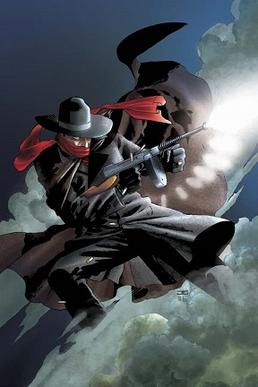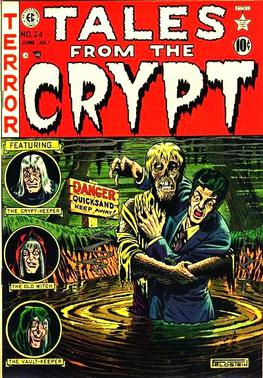This article needs additional citations for verification .(October 2023) |

A bondage cover, as opposed to a bondage magazine, was a general-interest magazine that featured bondage imagery on its cover, usually an image of a bound and gagged woman.
This article needs additional citations for verification .(October 2023) |

A bondage cover, as opposed to a bondage magazine, was a general-interest magazine that featured bondage imagery on its cover, usually an image of a bound and gagged woman.
These were the earliest examples of bondage cover art images, and ran from about 1910 (when the pulps became more common) until roughly 1975 (when the "men's adventure" type of magazines started to disappear).
The peak era for these seems to be the 1930s with weird menace and detective pulps and the 1960s heyday of men's adventure magazines.
Perhaps the earliest detective magazine to employ photographic covers was Actual Detective Magazine, whose first issue appeared in November 1937. The earliest use of a color photo on a cover is the February 1939 issue of True magazine, with the February 1940 edition apparently the first to feature a gag worn by a damsel in distress. The peak era for these was the era from roughly 1959 until 1986, when, due to the Meese Commission (a contribution by Park Dietz), and the end of a few of the publishers of detective (or "true crime") magazines, the main era of the bondage cover ended, though there were a few issues of Detective Dragnet in the late 1980s and early 1990s, and a brief revival from about 1994 until 2000, though even then they were few and far between (unlike the late 1960s, when at least two such covers could be seen monthly). Also, the use of over-the-mouth gags was common enough that the slang term "detective gag" is used for it.
Due to many detective magazines and comics being aimed at younger audiences, bondage covers often caused controversy. [1] Controversy intensified in the socially conservative 1950s, prompting psychiatrist Fredric Wertham to write his 1954 book Seduction of the Innocent. Examinations of bondage covers and other related phenomena let to the creation of the Comic Code Authority.
Pulp magazines were inexpensive fiction magazines that were published from 1896 until around 1955. The term "pulp" derives from the wood pulp paper on which the magazines were printed, due to their cheap nature. In contrast, magazines printed on higher-quality paper were called "glossies" or "slicks". The typical pulp magazine had 128 pages; it was 7 inches (18 cm) wide by 10 inches (25 cm) high, and 0.5 inches (1.3 cm) thick, with ragged, untrimmed edges. Pulps were the successors to the penny dreadfuls, dime novels, and short-fiction magazines of the 19th century.

Bondage pornography, also referred to as bondage erotica is the depiction of sexual bondage or other BDSM activities using photographs, stories, films or drawings. Though often described as pornography, the genre involves the presentation of bondage fetishism or BDSM scenarios and does not necessarily involve the commonly understood pornographic styles. In fact, the genre is primarily interested with the presentation of a bondage scene and less with depictions of sexuality, such as nudity or sex scenes, which may be viewed as a distraction from the aesthetics and eroticism of the sex scenario itself.

Doc Savage is a fictional character of the competent man hero type, who first appeared in American pulp magazines during the 1930s and 1940s. Real name Clark Savage Jr., he is a polymathic scientist, explorer, detective, and warrior who "rights wrongs and punishes evildoers." He was created by publisher Henry W. Ralston and editor John L. Nanovic at Street & Smith Publications, with additional material contributed by the series' main writer, Lester Dent. Doc Savage stories were published under the Kenneth Robeson name. The illustrations were by Walter Baumhofer, Paul Orban, Emery Clarke, Modest Stein, and Robert G. Harris.

The Shadow is a fictional character created by American magazine publishers Street & Smith and writer Walter B. Gibson. Originally created to be a mysterious radio show narrator, and developed into a distinct literary character in 1931 by Gibson, The Shadow has been adapted into other forms of media, including American comic books, comic strips, serials, video games, and at least five feature films. The radio drama included episodes voiced by Orson Welles.
Publication of comic strips and comic books focusing on science fiction became increasingly common during the early 1930s in newspapers published in the United States. They have since spread to many countries around the world.

Timely Comics is the common name for the group of corporations that was the earliest comic book arm of American publisher Martin Goodman, and the entity that would evolve by the 1960s to become Marvel Comics.

The Spider is an American pulp-magazine hero of the 1930s and 1940s. The character was created by publisher Harry Steeger and written by a variety of authors for 118 monthly issues of The Spider from 1933 to 1943. The Spider sold well during the 1930s, and copies are valued by modern pulp magazine collectors. Pulp magazine historian Ed Hulse has stated "Today, hero-pulp fans value The Spider more than any single-character magazine except for The Shadow and Doc Savage."

Marvel Mystery Comics is an American comic book series published during the 1930s–1940s period known to fans and historians as the Golden Age of Comic Books. It was the first publication of Marvel Comics' predecessor, Timely Comics, a division of Timely Publications.

Men's adventure is a genre of magazine that was published in the United States from the 1940s until the early 1970s. Catering to a male audience, these magazines featured pin-up girls and lurid tales of adventure that typically were promoted as true stories narrated in first-person by the participants or in an 'as told to' style. Usual stories included wartime feats of daring, exotic travel or conflict with wild animals. These magazines were also colloquially called "armpit slicks", "men's sweat magazines" or "the sweats", especially by people in the magazine publishing or distribution trades.

A science fiction magazine is a publication that offers primarily science fiction, either in a hard-copy periodical format or on the Internet. Science fiction magazines traditionally featured speculative fiction in short story, novelette, novella or novel form, a format that continues into the present day. Many also contain editorials, book reviews or articles, and some also include stories in the fantasy and horror genres.

Fiction House was an American publisher of pulp magazines and comic books that existed from the 1920s to the 1950s. It was founded by John B. "Jack" Kelly and John W. Glenister. By the late 1930s, the publisher was Thurman T. Scott. Its comics division was best known for its pinup-style good girl art, as epitomized by the company's most popular character, Sheena, Queen of the Jungle.

Martin Goodman was an American publisher of pulp magazines, digest sized magazines, paperback books, men's adventure magazines, and comic books, who founded the comics magazine company Timely Comics in 1939. Timely Comics would go on to become Marvel Comics, one of the United States' two largest comic book publishers along with rival DC Comics.
Popular Publications was one of the largest publishers of pulp magazines during its existence, at one point publishing 42 different titles per month. Company titles included detective, adventure, romance, and Western fiction. They were also known for the several 'weird menace' titles. They also published several pulp hero or character pulps.

The Green Lama is a fictional pulp magazine hero of the 1940s, created by American author Kendell Foster Crossen. He is commonly portrayed as a powerful Buddhist Lama, dressing in green robes with a red scarf and using his powerful skill set to fight crime. Slightly different versions of the same character also appeared in comic books and on the radio. Unlike many contemporary characters from smaller publishers, the Green Lama character is not in the public domain, as the author "wisely retained all rights to his creation".
Anatole France Feldman (1901–1972) is primarily known as a pulp magazine writer from the late-1920s to the late-1930s. He specialized in gangland fiction, appearing primarily in Harold Hersey's gang pulps, Gangster Stories, Racketeer Stories, and Gangland Stories. He also appeared in the rival magazines, Gun Molls and The Underworld.

Horror comics are comic books, graphic novels, black-and-white comics magazines, and manga focusing on horror fiction. In the US market, horror comic books reached a peak in the late 1940s through the mid-1950s, when concern over content and the imposition of the self-censorship Comics Code Authority contributed to the demise of many titles and the toning down of others. Black-and-white horror-comics magazines, which did not fall under the Code, flourished from the mid-1960s through the early 1980s from a variety of publishers. Mainstream American color comic books experienced a horror resurgence in the 1970s, following a loosening of the Code. While the genre has had greater and lesser periods of popularity, it occupies a firm niche in comics as of the 2010s.

Good Girl Art (GGA) is a style of artwork depicting women primarily featured in comic books, comic strips, and pulp magazines. The term was coined by the American Comic Book Company, appearing in its mail order catalogs from the 1930s to the 1970s, and is used by modern comic experts to describe the hyper-sexualized version of femininity depicted in comics of the era.
K.G. Murray Publishing Company is an Australian publisher primarily known for its publication of DC reprint comics. Established in 1936 in Sydney, Australia by Kenneth "K. G." Murray, the company was a family-owned and run business until its sale to Australian Consolidated Press in 1973.

Doc Savage was an American pulp magazine that was published from 1933 to 1949 by Street & Smith. It was launched as a follow-up to the success of The Shadow, a magazine Street & Smith had started in 1931, based around a single character. Doc Savage's lead character, Clark Savage, was a scientist and adventurer, rather than purely a detective. Lester Dent was hired to write the lead novels, almost all of which were published under the house name "Kenneth Robeson". A few dozen novels were ghost-written by other writers, hired either by Dent or by Street & Smith. The magazine was successful, but was shut down in 1949 as part of Street & Smith's decision to abandon the pulp magazine field completely.

Mickey Mouse Magazine is an American Disney comics publication that preceded the popular 1940 anthology comic book Walt Disney's Comics and Stories. There were three versions of the title – two promotional giveaway magazines published from 1933 to 1935, and a newsstand magazine published from 1935 to 1940. The publication gradually evolved from a 16-page booklet of illustrated text stories and single-page comic panels into a 64-page comic book featuring reprints of the Mickey Mouse and Donald Duck comic strips.